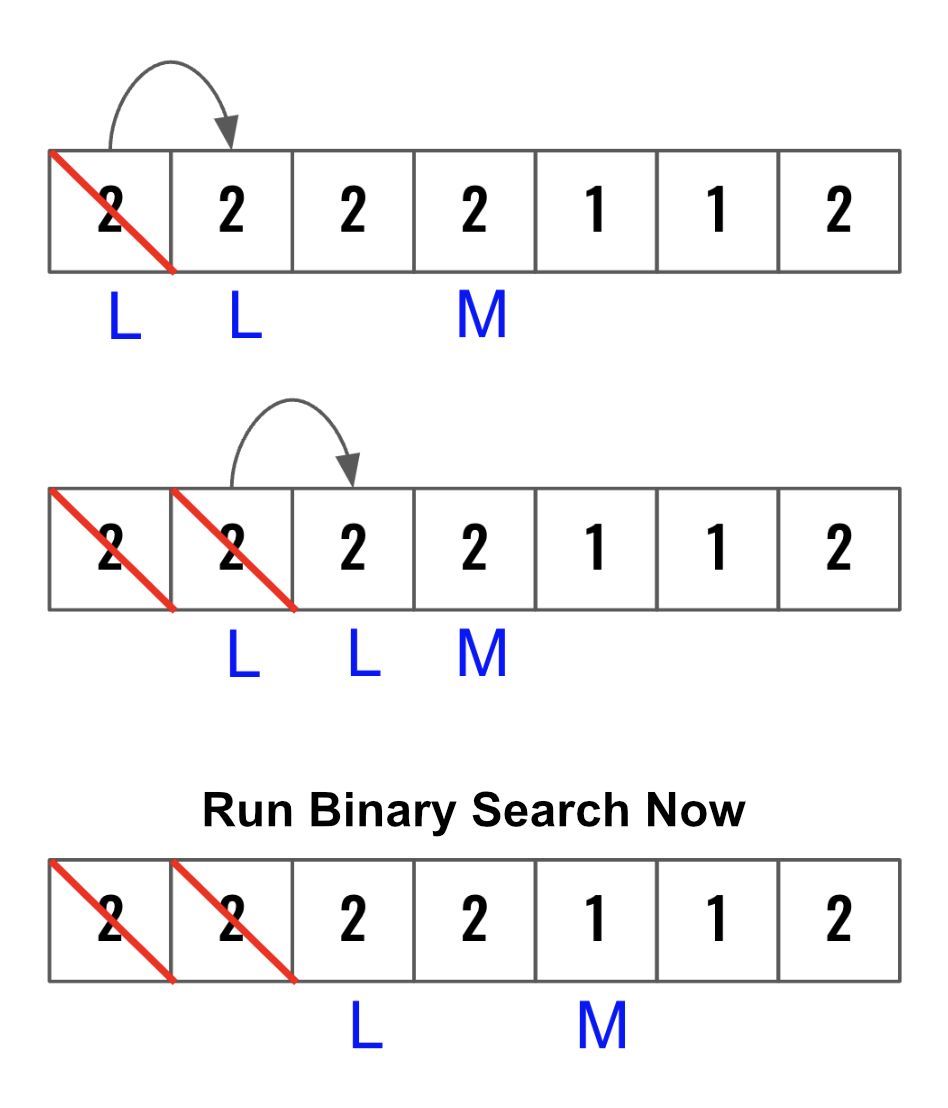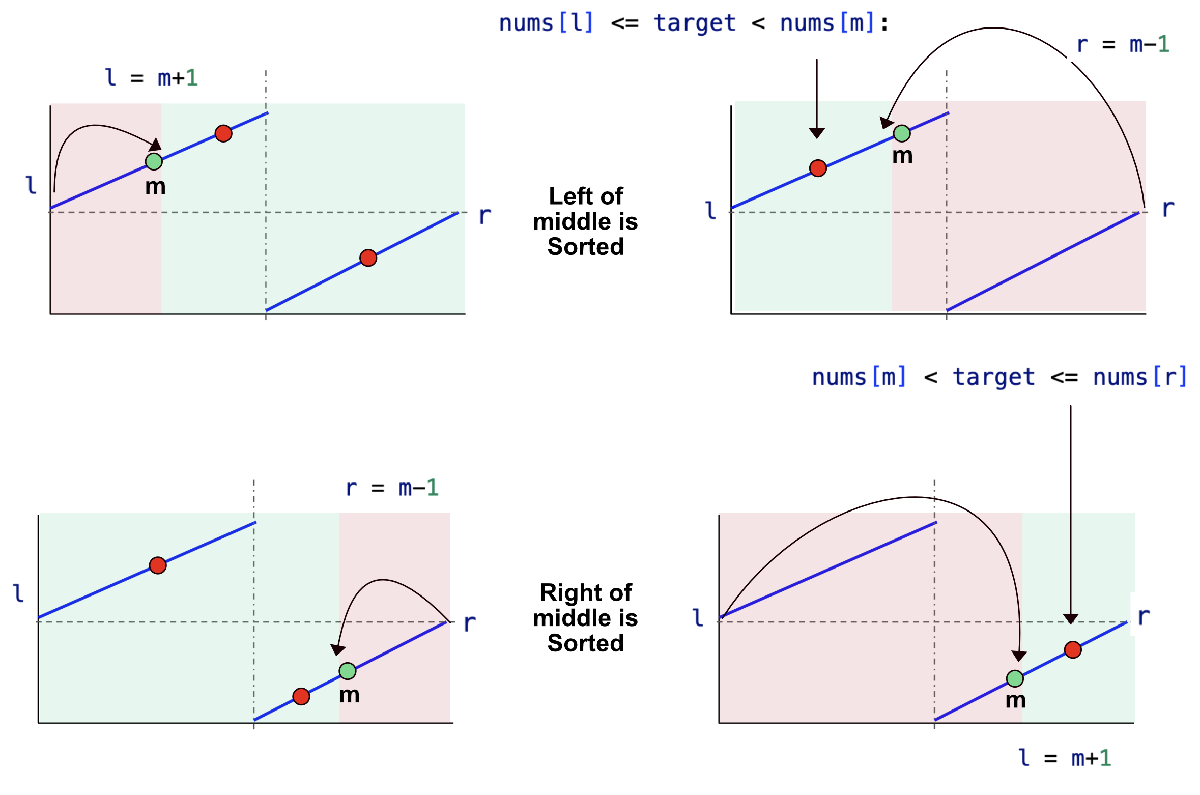Binary Search - Search in Rotated Sorted Array II
All diagrams presented herein are original creations, meticulously designed to enhance comprehension and recall. Crafting these aids required considerable effort, and I kindly request attribution if this content is reused elsewhere.
Difficulty : Easy
Binary Search, First find which side is sorted, Increase left pointer by 1 if nums[l] == nums[m]
Problem
There is an integer array nums sorted in non-decreasing order (not necessarily with distinct values). Given the array nums after the rotation and an integer target, return true if target is in nums, or false if it is not in nums.
Example 1:
- Input : nums =
[2,5,6,0,0,1,2], target =0 - Output :
True
Solution
Very similar to the previous problem. Search in Rotated Sorted Array
The main complexity is we can’t run binary search if
nums[l] == nums[m]. This this case just move the left pointer to right by one step.We can use the same 3 conditions from previous problem. However here we will use just different variation as both are valid.
- Just one major difference is since now
nums[l]andnums[r]can be same, we will use<=instead of just using>or<.
- Just one major difference is since now
Its very important to understand the above 4 diagrams. They shows the logic on how to move l and r pointers.
Code 1
Below is the almost exact code as the previous problem. Just change the <= in line 12 to < as there could be duplicates. Then incorporate the elif condition for right sorted nums[l] > nums[mid] in line 31 and finally add the else condition.
1
2
3
4
5
6
7
8
9
10
11
12
13
14
15
16
17
18
19
20
21
22
23
24
25
26
27
28
29
30
31
32
33
34
35
36
37
38
39
40
41
42
43
44
45
46
47
48
49
50
51
52
53
54
def rotated_search_with_duplicates(nums, target):
l, r = 0, len(nums) - 1
while l <= r:
mid = (l + r) // 2
# Return if target is found
if target == nums[mid]:
return True
# If left is smaller than middle then
# left of the middle is sorted.
if nums[l] < nums[mid]:
# there are three loctions where
# the trget could be present.
# We need to check for all three
if target > nums[mid]:
# 1. Target is right of middle and
# in the same partition
# In this case move left to mid +1
l = mid + 1
elif target < nums[l]:
# 2. target is in the right partition
# In this case move the left to mid+1
l = mid + 1
else:
# 3. Target is left of middle in the same
# sorted partition
# In this case move right to mid-1
r = mid - 1
elif nums[l] > nums[mid]:
# The left is not sorted, so right must be sorted
# Again check for three conditions.
if target < nums[mid]:
# 1. Target is in the left of the
# middle and in same partition
# In this case move right to mid-1
r = mid - 1
elif target > nums[r]:
# 2. Target is in the other partition
# In this case move right to mid-1
r = mid - 1
else:
# 3. Target is right of middle in the
# same sorted partition
# In this case move left to mid+1
l = mid + 1
else:
# Just move l to right as binary search can not work
l = l+1
return False
print(rotated_search_with_duplicates([2, 5, 6, 0, 0, 1, 2], 0))
1
True
Code 2
Here is another version where the reversed conditions are used. There are many ways to code so as long as you have understood the solution coding it might not be very difficult.
1
2
3
4
5
6
7
8
9
10
11
12
13
14
15
16
17
18
19
20
21
22
23
24
25
26
27
28
29
30
31
32
33
34
35
def rotated_search_with_duplicates(nums, target):
l, r = 0, len(nums) - 1
while l <= r:
mid = (l + r) // 2
# Return if target is found
if target == nums[mid]:
return True
# If left is smaller than middle then
# left of the middle is sorted.
if nums[l] < nums[mid]:
# there are two loctions where
# the trget could be present.
# We need to check for all two
# If the target falls in between left
# and mid pointer, then move right pointer
if nums[l]<= target < nums[mid]:
r=mid-1
else:
l=mid+1
elif nums[l] > nums[mid]:
# If the target falls in between mid
# and right pointer, then move left pointer
if nums[mid] < target <=nums[r]:
l=mid+1
else:
r=mid-1
else:
l = l+1
return False
print(rotated_search_with_duplicates([2, 5, 6, 0, 0, 1, 2], 0))
Runtime Complexity
The runtime will be O(log n) as we are simply running a binary search.


